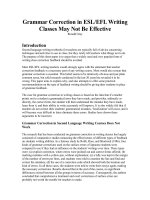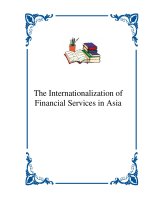Grammar Correction in ESL.doc
Bạn đang xem bản rút gọn của tài liệu. Xem và tải ngay bản đầy đủ của tài liệu tại đây (72.58 KB, 4 trang )
Grammar Correction in ESL/EFL Writing
Classes May Not Be Effective
Ronald Gray
Introduction
Second language writing textbooks for teachers are typically full of advice concerning
techniques and activities to use in class, but they rarely tell teachers what things not to do.
The purpose of this short paper is to argue that a widely used and very popular form of
writing class correction feedback should be avoided.
Most ESL/EFL writing teachers would strongly agree with the statement that teacher
correction feedback is a necessary part of any writing course. Most would also concur that
grammar correction is essential. This belief seems to be intuitively obvious and just plain
common sense, but solid research conducted in the last 20 years has revealed it to be
wrong. This paper aims to explain why, and also attempts to offer some practical
recommendations on the type of feedback writing should be giving their students in place
of grammar feedback.
The case for grammar correction in writing classes is based on the idea that if a teacher
points out to a student a grammatical error they have made, and provides, indirectly or
directly, the correct form, the student will then understand the mistake they have made,
learn from it, and their ability to write accurately will improve. It is also widely felt that if
teachers do not correct their students' grammatical mistakes, 'fossilization' will occur, and it
will become very difficult to later eliminate these errors. Studies have shown these
arguments to be incorrect.
Grammar Correction in Second Language Writing Courses Does Not
Work
The research that has been conducted on grammar correction in writing classes has largely
consisted of comparative studies measuring the effectiveness of different types of feedback
on students writing abilities. In a famous study by Robb, Ross, and Shortreed (1986), four
kinds of grammar corrections used on the surface errors of Japanese students were
compared to see if they had an influence on the students' writings over time. These types
were: (a) explicit correction, where errors were pointed out and correct forms offered; (b)
marking mistakes with a yellow pen, without explanation; (c) a tally was kept in the margin
of the number of errors per lines, and students were told to examine the line and find and
correct the mistakes; (d) the use of a correction code which showed both the location and
kind of errors. In all these cases, the students were told to write their essays again, making
the necessary corrections. Results showed that at the end of the course, no significant
differences existed between all the groups in terms of accuracy. Consequently, the authors
concluded that comprehensive treatment and overt corrections of surface errors are
probably not worth the trouble for teachers to make.
Additional studies have shown that neither the use of direct or indirect techniques in
correcting student errors has an influence on writing ability results. Moreover, making full
(every error is corrected by the teacher) or selective (only one type of error is marked at a
time) grammatical corrections is also not effective. There is no evidence of a delayed effect
to grammatical corrections, that is to say, an effect which later shows up. The kind of
instruction used by teachers in the study did not appear to have an impact on the results.
Nor was the lack of benefits of grammatical correction dependent upon the students'
gender, age, proficiency level, or educational background. (For additional information on
these studies, see Truscott's seminal article (1996), Krashen (2004a) and Loewen (1998).
Interestingly, many of these results are also true of corrections made in first language
writing classes).
The results of these studies should not be too surprising, for as John Truscott has noted:
Veteran teachers know there is little connection between correction and learning: Often a
student will repeat the same mistake over and over again, even after being corrected many
times. When this occurs, it is tempting for the teacher to say the student is not attentive or
lazy; however, the pervasiveness of the phenomenon, even with successful students, argues
against any such explanation. Rather the teacher should conclude that correction simply is
not effective. (Truscott 1996, p.
341).
Grammatical Correction in ESL/EFL Writing Classes Can Actually Be
Harmful To Students' Performance and Development
Numerous studies have revealed that grammar correction to second language writing
students is actually discouraging to many students, and even harmful to their writing ability
(Semke 1984; Kepner 1991; Sheppard 1992; and Truscott 1996). Generally those who do
not receive grammar corrections have a more positive feeling about writing than those who
did, wrote more, and with more complexity, than those who did receive grammar
corrections. Moreover, the time spent by students and teachers on correcting grammatical
errors causes needed attention to be sidetracked from other important elements of writing,
like organization and logical development of content.
Why Doesn't Grammar Correction Work?
The first reason why writing class grammar feedback doesn't work is that it treats only the
surface appearance of grammar and not with the way language develops (see Truscott 1996
for details). Secondly, learning grammar in a second language is a complex and gradual
process which occurs both developmentally and hierarchically (some items are acquired
before others). Compounding this is the fact that the learning of linguistic items does not
occur in a linear fashion, that the learning curve for an item is full of valleys and peaks,
progress and regressions. Therefore, for grammatical correction to work, the correction
must be precisely tied into the correct levels of this process. If a student is given a
correction for a stage he has not yet reached, it would not be effective. In order to offer
useful corrections, a teacher would need to precisely know where the student is
developmentally and hierarchically in terms of their grammar level. Yet because of the
complexity involved in learning grammar, this would be a virtual impossibility.
The third reason for the ineffectiveness of grammar correction involves the practicalities
associated with teachers comments and students understanding of these comments.
Research has shown that corrections made by second language writing teachers are
frequently arbitrary, not consistent, and greatly dependent upon the age and amount of time
the teacher has with L2 students. According to Zamel (1995), teachers also commonly
misread student texts and evoke abstract rules and principles in their comments. Moreover,
students often find teachers remarks vague, confusing, and contradictory, and feel that
teachers do not provide sufficient grammatical explanations about their writing mistakes
(Cohen 1987). Finally, students generally only make a mental note of the corrections they
have understood, and if they have to rewrite their papers, regularly do
not incorporate these corrections into their work (Cohen 1987).
Practical Implications For ESL/EFL Teachers
So what should a L2 writing teacher do? The quickest and most effective solution would be
for writing instructors to simply stop making grammar corrections. This would of course be
difficult for teachers to do because it has been shown most students strongly expect
teachers to notice their writing errors and comment on them, and they become quite
resentful if this does not occur. Adding to this pressure to give grammar feedback is the
fact that established curriculum of many language school and university writing programs
(especially overseas) is based on the value of grammar correction and if a teacher did not
employ it, they would have a good chance of being considered unprofessional.
One possible solution to this problem which I have found to be useful is to give periodic
short grammatical lessons at the beginning of class (the week after a big homework
assignment), and I discuss one or two widespread grammatical problem (e.g. articles,
prepositions) that I encountered in the students' homework. This usually has gone over
well and generally satisfied the students need for grammatical correction feedback.
Krashen (2004b) recommends teachers simply inform their students of the limitations of
grammar correction but I have doubts whether students would be satisfied with such an
explanation.
But just because grammar feedback is problematic does not mean all feedback is
ineffective. The general problem with is with the focus of S2 teacher's feedback. Studies
indicate that writing teachers spend most of their busy time offering grammatical or surface
level corrections in their comments. In other words, they commonly view their students'
work as language instead of writing teachers, concentrating primarily on form over content.
As a consequence, they address only one part of the writing process. What writing teachers
need to do is give priority to MEANING and MEANING RELATED problems, to make
remarks about students' texts instead of just form. Semke (1984) has demonstrated that
students who received comments from teachers only on content did much better and spent
more time working on their essays than those who received criticism only on grammar.
Specifically, this means that teachers should devote their time to areas like:
Organization
• Logical development of ideas and arguments
• Effectiveness of introduction and conclusion
Content
• Use of description
• Thesis statement
• Focus
• Use of facts and experience
• Cogency and consistency of how and why explanations
In short, teachers need to train themselves to set aside their red pens and examine ideas and
see what students are trying to say instead of simply looking for grammatical errors.
If ESL/EFL writing teachers are really concerned with improving their student's
grammatical competency, they should, in lieu of offering grammar correction feedback,
constantly stress in their classes the importance of outside reading. Studies have shown that
voluntary, 'light,' authentic reading (graphic novels, comics, the easy section of
newspapers, popular literature) in the target language greatly helps the overall writing and
grammatical skills of second language students (Krashen 2004a).
Teaching writing can be a very taxing and time-consuming process. Minimizing
grammatical error feedback has the advantage of greatly simplifying teachers jobs, giving
them needed time to spend on concentrating on other important elements of the writing
process, while also removing a significant impediment to their students learning how to
effectively write.









